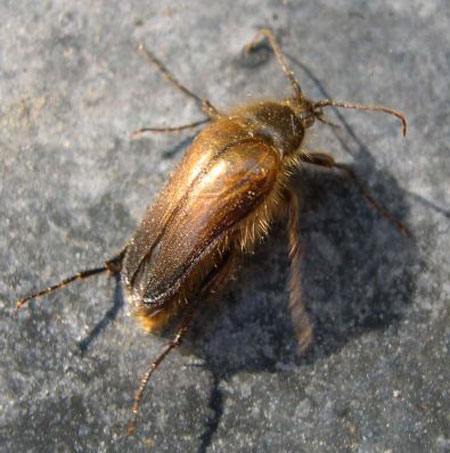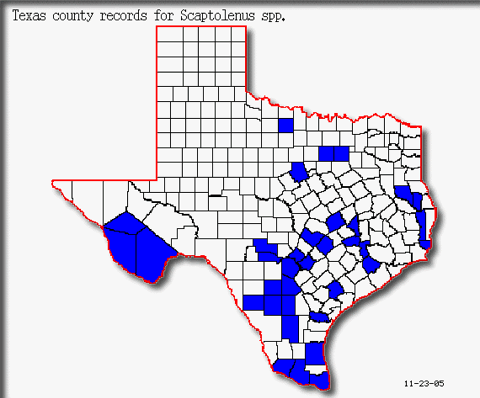
|
Return to Texas Entomology - Compiled by Mike Quinn

|
It was flying about during alight rain along with probably several dozen more.
The stench it carried was just awful and it stayed on my hand for well over an hour.
By the time it had worn off I could almost taste the smell.
It smelt like a rotten fish that had dried, with a slice of Limburger
Cheese placed on it before being sautéed in a stale urine gravy.

|
County Record Source: E.G. Riley, Nov. 2005
Biology: Females are unknown.
Males swarm during rainstorms. In eastern and southern Texas this swarming period is always late in the year, Oct-Dec. These are likely mating swarms, but I have never found a female, and it is likely that females do not fly and probably leave the soil only very briefly to attract a mate. (Ed Riley, pers. comm.)
Similar Species:
There are five species of Scaptolenus in Arizona and Texas.
Texas Taxa:
Scaptolenus lecontei Chevrolat
Scaptolenus ocreatus HornAt least one other species of Scaptolenus present in the Davis Mountains. (E.G. Riley, pers. comm.)
Arnett, R.H., Jr., M.C. Thomas, P.E. Skelley & J.H. Frank. (editors). 2002. American Beetles, Volume II: Polyphaga: Scarabaeoidea through Curculionoidea. CRC Press. 861 pp.
Horn, G.H. 1881. Notes on Elateridae, Cebrionidae, Rhipiceridae and Dascyllidae. Trans. Amer. Entomol. Soc., 9: 76-90.
Taber, S.W. & S.B. Fleenor. 2003. Insects of the Texas Lost Pines. Texas A&M University, College Station. 283 pp.
Turnbow, R.H., Jr. & J.E. Wappes 1977. Note on a flight by males of Scaptolenus ochraetus Horn. The Coleopterists Bulletin, 31(4): 346.
Werner, F.G. 1969. Two flights of Scaptolenus (Coleoptera: Cebrionidae). The Coleopterists Bulletin, 23(1): 26-27.
White, R.E. 1983. A Field Guide to the Beetles of North America. Houghton Mifflin Company, Boston. 368 pp.
01 Dec 2008 © Mike Quinn / Texas Entomology / Texas Beetle Information